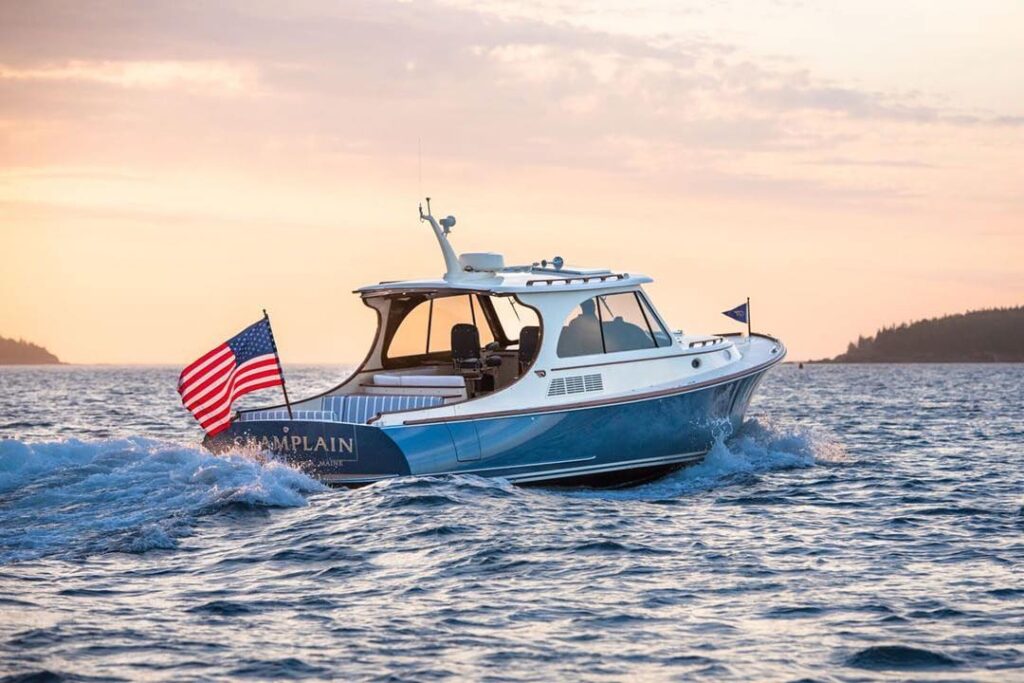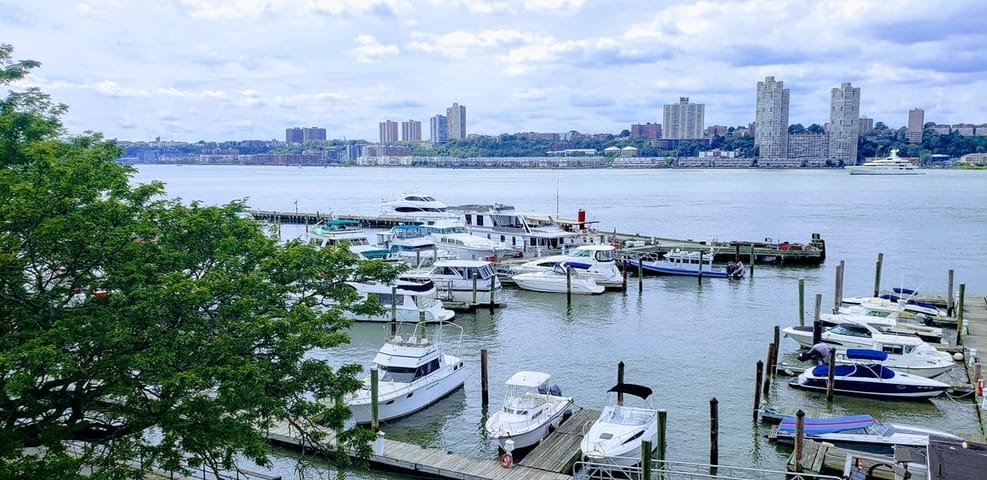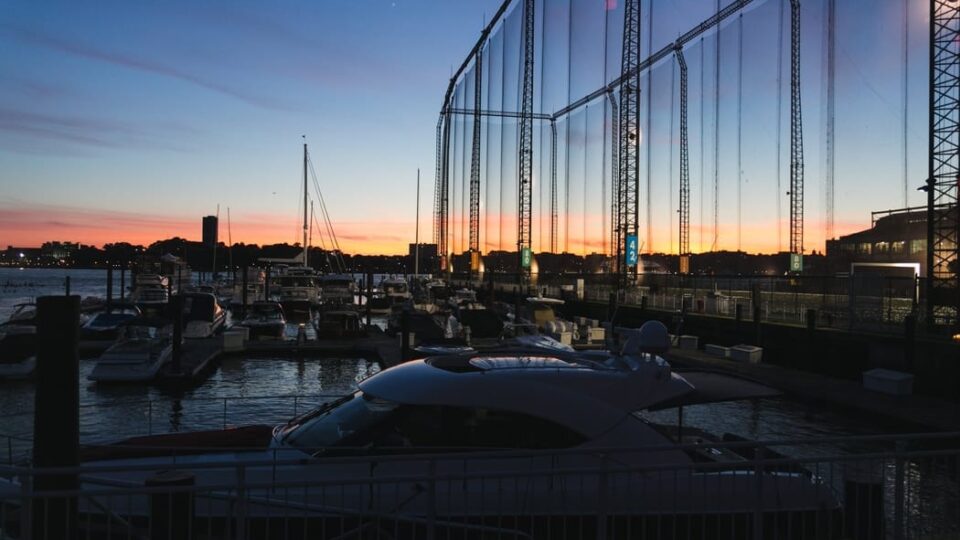Living on a Boat in New York: What you Need to Know (Best Liveaboard Marinas, Costs, etc)
Living in New York City with a magnificent waterfront view for less than $1,000 a month, including hot and cold water, a telephone, and cable television, appears to be a dream for many sailors. And, some New Yorkers are doing exactly that. They reside on boats moored at marinas around the boroughs. There are a few hundred liveaboards in the city, according to boaters, marina owners, and waterfront enthusiasts, who include young and old, single and married people, some with children. Living aboard in New York, however, can be hard for many as prices are exorbitant and some marinas don’t even allow it. So, in this article, I’m going to give information about the liveaboard life in New York. If you’re interested, keep reading!
Introduction: Liveaboard Life in New York
Allow your wonders to set sail on some of New York State’s most beautiful waterways. There are numerous places to choose and sail around. From the shiny waters of Lake Champlain in the Adirondacks to the sailor’s paradise of Lake Ontario. You can also cruise along Cayuga Lake or head out to the open ocean via the Long Island Sound.
New York City is a city and port in the northeastern United States, located at the mouth of the Hudson River. It encompasses Manhattan and Staten islands, the western sections of Long Island, and a tiny portion of the New York state mainland to the north of Manhattan, making it the largest and most influential American city. In truth, New York City is a collection of various neighborhoods spread across the city’s five boroughs—Manhattan, Brooklyn, the Bronx, Queens, and Staten Island—each with its own distinct culture. It’s possible that moving from one metropolitan neighborhood to the next is like traveling from one country to another. New York City is the country’s most populated and worldwide city.
New York is the country’s most ethnically diverse, religiously diversified, notoriously crowded, and, in many people’s eyes, most attractive urban center. There has been no other city in the United States that has contributed more pictures to the collective psyche of Americans. New York has been the largest and wealthiest city in the United States for the past two centuries. More than half of all people and products entering the United States passed via its port, and the unceasing flow of business has made change an inextricable part of city life. New York was always associated with possibility because it was a city on the rise, a metropolis too busy to be concerned about those who stood in the way of development.
As the cost of living in New York rises, astute citizens are looking for whatever advantage they can get. One lesser-known option is to abandon land entirely in favor of a life on the ocean. Houseboat communities have long existed in New York City, albeit they are generally few and far between. Indeed, as the cost of real estate rises, they are becoming increasingly more scarce. Slips — boat parking spots connected to a dock in a marina — are increasing in price, just like rents, condos, and co-ops. The good news is that they are still much less expensive than most rents.
There’s a reason why so little information regarding this topic is publicly available. This is because living on a boat in the New York area as your full-time, permanent residence is technically illegal at every marina. Therefore, intrepid ambitious liveaboards, proceed at your own risk. However, if you have even the slightest inclination that you would enjoy living on a boat, whether in NYC or elsewhere, you should definitely give it a shot!
Key Considerations of the Liveaboard Life in New York
Living aboard your sailboat is a fantastic adventure, full of rewarding experiences but also with some difficulties. Every boat is unique, and living on one can be a highly cost-effective way to live in a pricey city. However, don’t forget about the expenditures of buying and maintaining a boat. Some repairs might cost thousands of dollars. As a result, keep in mind that any money you save on rent will almost certainly be spent on boat upkeep in the long term. Keep in mind to check the blogs that detail the expenditures of living and cruising on boats on a monthly or yearly basis.
Remember that you are not linked to a water or sewage system while you live on a boat. Water is easy to come by in the summer; simply fill up your tank from a hose right at your slip. Water is an annoyance in the winter, but it is manageable. You’ll be given an extra-long hose, or some docks will connect their hoses and fill straight from land-based pumps. This can be a problem. When people leave water in the hose, it freezes, and you have to do stupid things to unfreeze it, but it’s perfectly achievable. Note that it’s not an issue if you have large water tanks.
During the winter, liveaboards are frequently asked if their boats become cold. The answer is no; heating small, airtight cabins is a breeze. However, there are other more issues. One is the bathroom. Boats are not permitted to dump sewage by law. That means the garbage is stored onboard in a tank. A hose can be linked to the boat at better marinas so that the contents of the tank can be pumped into a septic system. Those who aren’t so lucky must empty their waste tanks into a toilet on land.
Note that there is insufficient pump-out services for heads in any of the NY marinas. Meaning that there are no pumps to clean the toilet tanks. This can be a big problem because you have to do everything in the marina bathrooms. Keep in mind that you shouldn’t shower aboard your boat, especially in the winter, because of the dampness. This means that you’ll be using those bathrooms frequently. In addition, many sailors utilize pee-only heads because it drastically decreases odors aboard the boat.
Keep in mind that living aboard in the NY marinas can be either easy or extremely difficult. For example, living aboard in the Chelsea Piers can be quite cheap in comparison with renting an NYC apartment. If you can acquire a mooring there, the 79th St. boat basin is likely the cheapest option for the summer. Monthly or seasonal prices are preferred, however weekly and transitory rates are also available. Note that as there is no launch service and it can get bouncy there, you’ll need a dinghy.
Living aboard at Liberty Landing can also be a great experience according to many boaters. There are around 80 to 100 boats with full-time people. For what it’s worth, they don’t allow liveaboards, but they do allow stay-boards. Each boat is equipped with its own electrical meter. Generally, it is not cheap, but the location is excellent, with a park nearby. They also have a structure with showers, toilets, and other amenities. In the marina, there is another shower facility located much further west. Moreover, the Hudson is well-protected against wakes.

>>Also Read: Living on a Boat in California
Things to Keep in Mind about Liveaboard Marinas in New York
In the NYC area, no marina will declare they welcome liveaboards. Instead, look for marinas that offer “wet winter storage” or “in-water storage,” as well as those that accept “frequent stayaboards.” Many marinas welcome stayaboards, but you’ll need a separate permanent address for legal and tax purposes, as well as another place to go in an emergency. Bear in mind that you do not have the same rights as an apartment renter. Your slip does not constitute your residence. In summary, many marinas permit full-time residents, but it is not legal, despite the fact that many people have done so for years. This can be inconvenient at times because they function under the assumption that every tenant does not live there full time, even if they are aware that they do. And this is why you must make alternate preparations.
This was not an issue for many, but every marina is different. Because there are other marinas on the same canal, you must pick between expense and facilities over convenience. Among the cheapest marinas is considered to be the 79th Street Basin. Note that only a few places in the greater New York area offer year-round dockage and services. And, they’re all several times the price of the 79th Street Boat Basin. To find out about current policies, you’ll have to contact the marinas. Many individuals live in marinas surrounding New York, either part-time or full-time, but you must be discreet and follow the laws of the marina where you are staying. The availability of liveaboard spots varies greatly from marina to marina. Some individuals care while others are not if you stay for the entire year.
Keep in mind that Liberty Landing marina, which is the most popular one for liveaboards, is open all year. However, Liberty Marina does not allow winter liveaboards, despite the fact that it is said to be much safer. On the other hand, Liberty Marina has incomplete administration and isn’t well kept, but it’s safe and the showers are warm. But, Liberty Marina doesn’t belong to NYC. The marinas are on the mainland in New Jersey. Small changes apart, you’re in a different tax jurisdiction with its own set of rules—not New York City or State. You may want to think about complying with New Jersey state law, which requires every powered watercraft operator to have a safety training certificate from either NJ or their home state.
All in all, you should always check the rules and regulations about liveaboards as they vary from marina to marina. And, most of the marinas don’t accept liveaboards in New York. Many people believe that liveaboards in NYC just want to avoid taxes and don’t contribute to society. However, this is not true. Liveaboards claim that they give up a lot in terms of comfort and stability. They emphasize that they are continuously working to maintain their boats and that marina owners pay the same amount of taxes as apartment building owners. And, of course, it isn’t possible to take a vacation every day. The truth is that it takes a lot of effort.
Best Marinas in New York
- Safe Harbor Greenport
- Mitchell Park Marina, Greenport
- Safe Harbor Stirling, Greenport
- Pier 25 Marina, NY
- Chelsea Piers Marina, NY
- West 79th Street Boat Basin, NY
- Safe Harbor Glen Cove
- Port of Rochester Marina
- Oyster Bay Marine Center & Cooper Bluff
- Sag Harbor Village Marina
- Safe Harbor Willsboro Bay
- Sailors Haven Marina Fire Island National Seashore
- Fire Island Pines Marina
- Strong’s Water Club & Marina, Mattituck
- Safe Harbor Gaines, Rouses Point
- North Cove Marina
- Skyport Marina
- Westlake Marina, Montauk
- Gurney’s Star Island Marina, Montauk
- Montauk Anglers Club & Marina
- Liberty Landing Marina, Jersey City
- ONE°15 Brooklyn Marina
- The Island Marina, Shelter Island
- Donovan’s Shady Harbor Marina, New Baltimore
- Clayton Harbor Municipal Marina, Clayton

>>Also Read: Living on a Boat in Florida
Cost of the Liveaboard Life in New York
The cost of the liveaboard life in New York depends on many factors. Firstly, it depends on the marina, the location, and the type of your boat. Powerboats have a lot more space than sailboats, but they are also more expensive. Sailboats have less interior capacity than motorboats, however, nowadays you can find a decent sailboat at a reasonable price. It’s important to note that houseboats aren’t sailboats or powerboats. They’re supposed to stay in one place and not move. In any event, practically every boat must have a running engine, and you must have insurance in order to maintain it in almost any marina. Depending on the state of your boat, your insurance costs may vary dramatically.
The size of your boat is another consideration when it comes to the slip fees. For example, 37ft is a great size for 2 persons. Many people make the mistake of purchasing a large boat and then regret the dock fees, which are paid on foot, and maintenance expenses. Whether you’re not sure, borrow a friend’s boat for a few days or rent a boat of the size you want on Airbnb to see if it’s the appropriate fit.
A number of liveaboards arrived as renters in NYC. For years, the Boat Basin Marina was run by a concessionaire, and rentals, many of which were houseboats and clearly not seaworthy, were permitted. The rent was low — it’s now $120 per linear foot during the summer season, or $800 per month for a 40-foot boat, and $105 per foot in the winter, implying that docking a boat of that size at 79th Street would cost $10,000 per year. This does not, however, cover the significant expenditures of purchasing and maintaining a boat, as sailors point out. On the other hand, for boats under 50 feet, the Chelsea Marina charges $40 per week every linear foot, so a month would cost roughly $7,000. Lastly, docking fees vary and depend on the location and length of the boat. You can expect to pay from $5,000- $7,000 annually.
The Liveaboard Community in New York
For many reasons, people live on boats. Some people are uninterested in sailing and would rather have a gorgeous house on the water. Others are those who live and work on the water’s edge, known as sea dogs. Others are visionaries who are putting money and materials into an epic sail. Live-aboard New Yorkers say they spend an average of 10 hours a week, often more, working on their boats and thousands of dollars a year maintaining them. So you must either be wealthy or self-sufficient. Anyone who lives on a boat must be self-sufficient in some way, but some liveaboards make self-sufficiency a religion.
But, why isn’t there a vibrant liveaboard community in New York City, which has 578 miles of coastline? While it’s impossible to say for sure, new estimates for Manhattan imply that the number of year-round liveaboards may be as low as 50. The fact that New York has much fewer liveaboards than many smaller towns is due to a lack of year-round mooring space. However, the local government claims that Pier 79 will be upgraded, resulting in a massive increase in the pier’s capacity to serve year-round residents. While it’s unclear how many of the 780 people on Pier 79’s 14-year waitlist will finally be able to live on the water year-round, the proposal promises to result in a significant increase in NYC liveaboards.
The liveaboards enjoy and appreciate the recreational boaters, and they want the slips to be full of all different kinds of boats, but they regret their community’s precipitous decline, and they point out that the marina’s numerous vacant spots make the boat basin feel sad in the winter. It’s important to note that only 24 boats were docked at the Basin Marina last winter, ten of which were liveaboard vessels. There used to be approximately 104 year-rounders, now it’s down to 33 boats at Pier 79 on the Upper West Side to West Side Rag. In general, the docking fees for living there are less than $1,000 per month.
In general, according to many NYC liveaboards, the liveaboard community in New York exists it’s just that it isn’t that vibrant. This is because of the State’s laws, high prices, and the marinas’ restrictions. In addition, many sailors prefer other states to liveaboard as the environment, marina slip fees, and the community are the most important considerations for a potential liveaboard.
Living on a Boat in New York – The Bottom Line
Hopefully, you now have a firm grasp on whether or not New York is the ideal fit for you. There are many beautiful places to live aboard your boat in New York. However, you have to always contact the marina of your choice before planning your liveaboard life. Also note that prices can be high and the marinas that accept liveaboards are few. Living in New York is not cheap, but you get what you pay for. The weather is mostly pleasant, there are opportunities for everything and numerous activities to choose from. If you’re not sure whether you want to live there full-time, spend your next vacation anchored at one of the marinas to get a feel for the place. It can give you a taste of what your life might be like if you decide to move forward.
So, are you interested in becoming a New York liveaboard? Many marinas provide boaters with thorough information on some of the factors involved, such as monthly prices and other amenities. Some marinas impose quotas or other restrictions on the number of liveaboards that can be accommodated. Check the website of each harbor or marina to verify if liveaboards are permitted. What are the rules for tenants who live aboard? Is there a waiting list for liveaboard slips? Don’t forget to inquire about parking, security, restrooms, showers, shared areas, WiFi, and whatever other concerns you might have.
I wish that this article gave you a grasp of things about the liveaboard life in NYC. It can be hard but if you are determined to liveaboard you will certainly be able to do so. Wish you the best!
